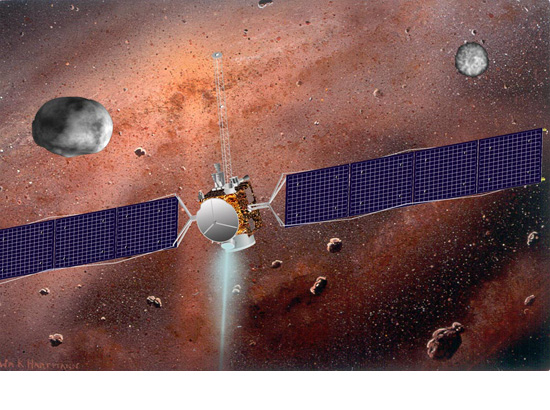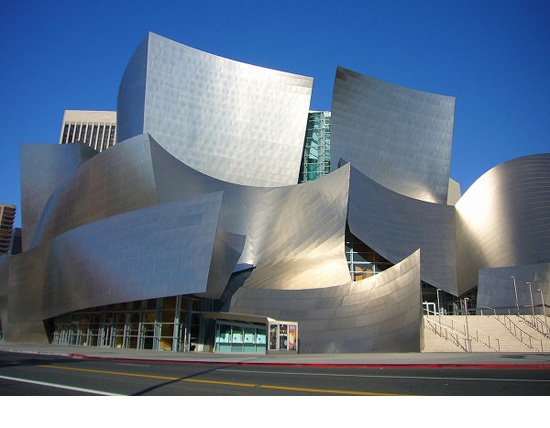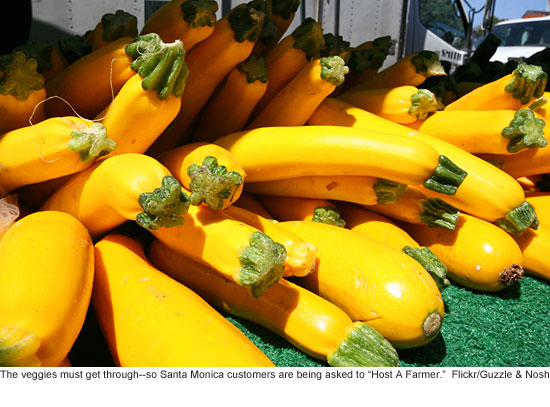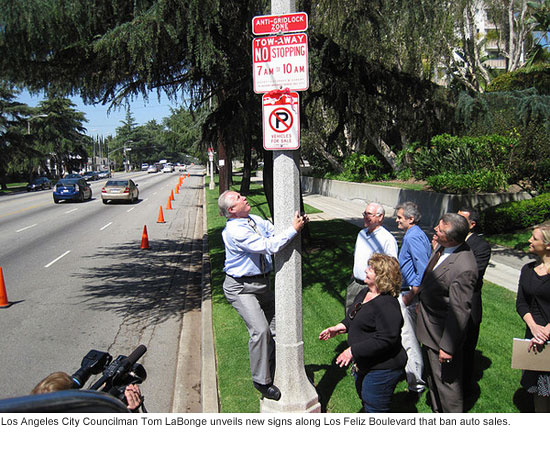Calling all asteroids
June 16, 2011

What better way to start your summer than visiting a couple of asteroids?
Thanks to JPL/NASA’s Dawn Mission spacecraft, launched nearly four years ago, you can do just that. As the intrepid interplanetary explorer closes in on the asteroid belt, here’s a chance to learn a bit more about its two principal targets and what they can tell us about our own world: the giant asteroids known as Ceres and Vesta.
It’s all part of the Chautauqua Series of educational presentations by the Mountains Recreation and Conservation Authority, and sponsored by the Santa Monica Mountains Conservancy. It takes place this Tuesday, June 21—and every third Tuesday—at Temescal Gateway Park’s Woodland Hall. Meet the neighbors, share a cup of coffee, and explore the universe together.
Both the 90-minute program and parking are free.
Temescal Gateway Park is located at 15601 Sunset Blvd. in Pacific Palisades. Full information and directions to the park may be found here, or you can call (310) 858-7272 ext.131.
Posted 6/16/11
The patron saint of…government?
June 16, 2011
Los Angeles County’s top auditor, Wendy Watanabe, thought it had to be a joke or a scheme. At a time when government has come under the public lash, who would mail a $10,000 cashier’s check to the County of Los Angeles—especially someone in Washington State?
And who, in an accompanying note, would write something like this?: “In this time of economic difficulties, governments need all the help they can get. Please put this anonymous check to good use. God bless you.”
Given such unusual circumstances, Watanabe and her staff figured that the check might be counterfeit; the office has had some experience with that kind of thing in the past. But then, remarkably, it cleared the bank.
“We were elated that there would be such a good person out there,” said Watanabe. “Most of the time we get attacked for overspending. For someone to actually donate to the government, it’s just unheard of.”
“Why this person picked L.A. County, we have not a clue,” she added. “Maybe they’ve sent $10,000 to every government agency out there.”
For now, because of bank confidentiality rules, there’s no way to know much beyond the basics. The check was mailed directly to the Auditor-Controller’s Office. It was purchased at Banner Bank on May 2 and lists a toll free number in Walla Walla, Wash. A bank representative, contacted by a writer for Supervisor Yaroslavsky’s website, would reveal only that the transaction occurred at a branch in the town of Bellingham, about 90 miles north of Seattle. The branch employee who issued the check did not return several phone calls.
Every year, the county receives thousands of dollars in donations of various sorts, some of which are bequeathed in wills. For the most part, however, the recipients are specified, Watanabe says, with the lion’s share of money going to departments that deal with young people, such as children’s services and probation.
“Very rarely,” she says, “do we get a donation to a bunch of accountants and auditors. It’s a good feeling that they trust us.”
Unless the Board of Supervisors directs otherwise, Watanabe says, the money will be deposited in the county’s general fund.
Posted 6/16/11
Relax with dad at Descanso
June 15, 2011

Give Dad the peace and quiet he always begged for amid the natural splendor of Descanso Gardens.
Father’s Day entertainment begins with the Jet Set Quartet, a quasi-barbershop group of musicians who play tunes from the Atomic Age. They start their set at 1 p.m., which will give dads just enough time to settle down to barbecue from Patina Restaurant Group. There are limited tables and chairs, so bring lawn chairs and picnic baskets if you have them.
Take some time to smell the roses–5 acres of them are in peak season for the holiday. Also make sure to visit the Japanese Gardens, stop by the bird observation station, or tour the grounds on the “green” tram. For kids, an enchanted railroad takes a shorter route through the gardens.
Admission to the gardens is $8 for adults, $6 for seniors and students, $3 for children ages 5-12 and free for kids under 5. The band is free, but the barbecue will be sold at additional cost. Directions and other logistical details are available on Descanso’s website.
Posted 6/15/11
Go west, young dad
June 15, 2011
Every Sunday is “Family Day” at the Autry National Center. And on this Father’s Day, there’ll be special interactive activities and entertainment to please dads and their kids.
Visitors will learn about California’s mid-19th century life and search for gold in a re-created panning station with “Gold Rush,” from 11 a.m. to 3 p.m. At noon, there’s an outdoor story time, during which the Autry’s teachers will read dad-themed selections from their library. From noon to 3 p.m. cowboy poets from Western Music Association will play western classics. At 1:30 p.m., kids can make dad his very own bolo tie in a craft workshop. The Autry’s café is offering a special barbecue menu. Of course, you can bring your own fare and picnic on the lawn.
The Autry is an inter-cultural history center in Griffith Park that offers a taste of the American West through artifacts, art, research libraries and educational programs. On Sunday, it will have 3 docent-led tours at 11:30 a.m., 1, p.m., and 3 p.m. as well as a “Hands-on History Tour” at 1:30 p.m., where visitors can pick up and feel some of the items from their collection.
Admission to the Autry is $10 for adults, $6 for students and seniors, $3 for kids ages 3 to 12, and free for kids under 3. It is open from 11 a.m. to 4 p.m. on Father’s Day. Directions to the center are available online.
Posted 6/15/11
A symphony of support
June 15, 2011

Show Dad what a conscientious world citizen he raised by taking him to Walt Disney Concert Hall for a special benefit concert on Father’s Day. “Beethoven 9 for Japan” features Beethoven’s Ninth and Samuel Barber’s “Adagio for Strings.” Proceeds will help fund disaster relief for the devastating 2011 Tōhoku earthquake and tsunami in Japan.
An ensemble of musicians from the LA Philharmonic and other area orchestras will be conducted by Guido Lamell, who is music director of the Topanga Philharmonic and an L.A. Phil violinist. Also performing will be soprano Elissa Johnston, tenor Robert MacNeil, mezzo-soprano Janelle DeStefano, and bass-baritone Michael Dean. Musicians are donating their time and talent for the event.
Tickets cost $30-140 and may be purchased via Ticketmaster or in person at the Disney Hall Box office. One hundred percent of the proceeds will go to people in critical need in Japan via the U.S.-Japan Council Earthquake Relief Fund.
The show starts at 7 p.m. on June 19 at the Disney Hall, 111 South Grand Avenue. It’s just a short walk from the Civic Center stop on Metro’s Red Line, so plan your trip to avoid traffic and parking.
Posted 6/15/11
New beach rules could be game-changers
June 15, 2011
 It’s harder than people think to set a trend in Southern California. Take the quest to establish beach tennis at, well, the beach.
It’s harder than people think to set a trend in Southern California. Take the quest to establish beach tennis at, well, the beach.
Five years ago, a small group of South Bay tennis pros picked up the sport, a cross between beach volleyball and regular tennis that has long been popular in South America and Europe.
“It’s a natural,” says Donny Young, a Hermosa Beach early adapter, who heard about the sport from a fellow tennis pro, who had learned it from a European player. “Easier than tennis, easier than volleyball, you’ve got the sand and water and sun, and it’s inclusive.” Within a few months, Young says, he had regular matches and friends and onlookers were clamoring to play.
But since 2008, Young and his fellow enthusiasts have been struggling to find spots on Los Angeles County beaches where they can reliably volley their extra-light balls and swing their extra-short racquets. The reason? A combination of old rules and new competition for coastal space.
“Beach tennis is just one piece of it,” says Kerry Silverstrom, chief deputy director of the Los Angeles County Department of Beaches and Harbors. Beach attendance, she notes, has risen to record levels during the past five years. According to the latest figures from the county fire department’s lifeguard division, some 50 million people so far have come to the county beaches during the 2010-11 fiscal year, even with the chilly weather that dampened attendance last summer; that’s more than a 25% increase over 2005-06 beach attendance.
Part of it has to do with the economy, which has kept locals close to home during summer vacations, she says, but part is simply population growth and California lifestyle.
Ask Silverstrom to elaborate, and she’ll offer a litany of the many interests that, in recent years, have come to vie ever more intensely with swimmers and sunbathers for space on the county’s 80 or so miles of coastline: beach soccer, beach volleyball, surfers, bodyboarders, skimboarders, paddle boarders, hang gliders, kiteboarders, surf skiers, triathletes, bicyclists, filmmakers, surf camps, boot camps, cheerleading camps, day camps, weddings, Bar Mitzvahs, memorial ceremonies—“you name it,” she says. And that’s not including the non-human beachgoers from grunion to protected shorebirds who can’t be disturbed in their roosts.
As a result, the county’s Beach Commission and the Department of Beaches and Harbors have been working on an overhaul of the county’s beach ordinance, a wide-ranging set of new rules expected to come before the Board of Supervisors in a couple of months.
The idea, says Silverstrom, is to make the existing ordinance more flexible and inclusive. “Most of its sections,” she says, “have been in place since 1969.”
Rules about watercraft and beach ball sizes are being reconsidered, she says, as are special requests from the film industry and other important economic interests.
“It’s a balancing act, though,” she says, laughing. For example, a recommendation giving beach authorities leeway to give certain privileges to film crews—letting them drive on the sand under certain circumstances or launch personal water craft from the sand that are otherwise banned from operation within 300 yards of the shoreline—had to be rethought when the beach they had in mind turned out to be home to the threatened snowy plover.
Few have followed the give and take more closely, however, than the beach tennis constituents.
Popular for at least 30 years on the beaches of South America and Europe, beach tennis is played on the sand by 2-person teams who volley a soft, low-pressure ball over a high net. Players wear board shorts and bikinis; polite tennis applause is less common than rock music.
The sport began to garner publicity in the U.S. when a New York real estate developer began promoting it in 2005 on Long Island. Young and other local enthusiasts say the sport spread to Southern California when South Bay tennis pro Joe Testa took it up and recruited Young and another tennis pro, Marty Salokas, the following year.
By 2008, beach tennis had enough West Coast players to justify a tournament and some media attention. “But once the tournament was over, there was nothing,” says Salokas. “It just didn’t have the grass roots here.”
 So the group began putting up flyers, sending out emails and—crucially—organizing meets on South Bay beaches, using vacant beach volleyball areas or portable nets and equipment that they would buy from the East Coast promoters and set up in the sand themselves.
So the group began putting up flyers, sending out emails and—crucially—organizing meets on South Bay beaches, using vacant beach volleyball areas or portable nets and equipment that they would buy from the East Coast promoters and set up in the sand themselves.
The impromptu courts worked well in some spots—Hermosa Beach, for example. “But anyone who tried to play in Manhattan or Redondo or El Segundo or other places was told, ‘Hey, you just can’t set that up anywhere you want’,” Salokas says.
Moreover, they discovered that the existing beach ordinance makes it illegal to throw, kick or roll anything on the sand that is smaller or denser than a 10-inch inflatable rubber playground ball. So the group began lobbying beach cities and the county for an exception.
They scored in Hermosa, where last year two beach tennis courts were designated by the city. But Lucy Streeter, a private swim instructor and former professional high diver from Rancho Palos Verdes who helped organize the grassroots efforts, says their pleas to the county initially got lost in the larger beach ordinance revision. So several months ago, the group launched a petition drive and a letter writing campaign.
Now, officials say, they are definitely on the radar, and stand to benefit from the new rules, if they are approved later this summer.
“We have staff currently looking for locations where we might put a permanent beach tennis court or two,” says Silverstrom, suggesting Malibu’s Zuma Beach or Dockweiler State Beach near Marina del Rey.
That’s good news to people like Streeter, a mother of three who took up the sport because it seemed so easy.
“The hardest part about it,” she says, “has been finding a place to play.”
Posted 6/15/11
Invite a farmer to a 405 sleepover
June 15, 2011
 You can close the freeway, but please—don’t mess with our fresh-grown farmers market fare.
You can close the freeway, but please—don’t mess with our fresh-grown farmers market fare.
The Santa Monica Farmers Market, bracing for the mid-July closure of the 405 Freeway, has come up with a “Host A Farmer” program to ensure that growers can deliver the goods for the city’s markets scheduled for Saturday, July 16, and Sunday, July 17, despite the 53-hour shutdown.
With the midsummer bounty of corn, tomatoes, peaches and figs coming into season, a presumably gridlocked metropolis will be counting on local farmers markets for entertainment as well as sustenance during the weekend.
Customers and fresh food enthusiasts can do their part by offering to put up a farmer for the weekend, allowing growers to get into town ahead of the shutdown, which begins with ramp and lane closures on the evening of Friday, July 15. (The freeway will be completely closed in both directions all of Saturday and Sunday, with a scheduled reopening of 5 a.m. on Monday, July 18. The northbound 405 will be closed from the 10 Freeway to the 101. The southbound 405 will be closed from the 101 to Getty Center Drive. This printer-friendly brochure has all the closure details.)
This flyer—to be distributed starting Wednesday at the Santa Monica Farmers Market at Arizona Avenue and 2nd Street—suggests that market customers approach growers directly if they’d like to offer a place to stay.
Arrangements also are underway to allow farmers to park their trucks all weekend in Santa Monica city lots. Other nearby markets—including those in Beverly Hills, Encino, Hollywood and Sherman Oaks—say they’re planning to be open for business and, at least so far, are counting on their farmer-vendors to be able to get through on surface streets and freeways, such as the 5, 101 and the stretch of the 405 south of the 10 that will remain open.
Posted 6/21/11
Curbside sales hit a roadblock
June 15, 2011
 Parked bumper-to-bumper on busy streets throughout Los Angeles County, they seem to materialize out of nowhere, lines of used cars with hand-lettered “for sale” signs in the windows. And while those vehicles may look like a bargain, they can carry a stiff price for the surrounding neighborhoods and beyond.
Parked bumper-to-bumper on busy streets throughout Los Angeles County, they seem to materialize out of nowhere, lines of used cars with hand-lettered “for sale” signs in the windows. And while those vehicles may look like a bargain, they can carry a stiff price for the surrounding neighborhoods and beyond.
A study by the DMV in Los Angeles last year concluded that, among other things, these curbside auto bazaars have led to hazardous traffic jams, increased pollution and rampant consumer fraud, including the sale of stolen cars with fake paperwork. In some cases, individual sellers were found to be illegally hawking multiple cars, turning the public streets into their personal lots.
On Tuesday, armed with that assessment, the Board of Supervisors decided to slam on the brakes, giving initial approval to an ordinance introduced by Supervisor Gloria Molina that would ban vehicle sales on nearly 1,000 specific blocks in the county’s unincorporated areas. A second and final vote is scheduled for next week.
The board’s action comes one month after the City of Los Angeles, led by City Councilman Tom LaBonge, banned auto sales along Los Feliz Boulevard and Franklin Avenue near Griffith Park, where the car trade has long flourished on weekends.
Helping lead the enforcement strategy was lawyer Sari Steel of the County Counsel’s Office, who worked closely with city and county officials, as well as with the DMV and law enforcement. “Their days are numbered,” she says of the outlaw sellers.
For years, both the county and city had laws broadly banning vehicle sales on public streets. But more than a decade ago, Steel says, the city’s measure was successfully challenged in federal court as an unconstitutional infringement on commercial free speech, prompting the county to stop enforcing a similar ordinance. The speech in question: the “for sale” signs.
In recent years, Steel says, a reexamination of state vehicle codes and other court decisions gave way to a new enforcement strategy, one targeting specific streets where it can be determined that a substantial government interest is at stake, such as neighborhood safety. The county’s proposed new ordinance hits sellers hard in the pocketbook; if they’re caught twice in a restricted area within 30 days, their cars are impounded and penalties are imposed.
Steel acknowledges one potential shortcoming to the approach: some determined sellers may simply move from one of the 78 streets listed in the ordinance to set up shop elsewhere. And on Tuesday, that possibility clearly was on Supervisor Don Knabe’s mind.
“My feeling is that you’re either all in or you’re all out,” an irritated Knabe declared. He argued that a sales ban on certain streets would do nothing to solve a problem that he described as endemic in his district. As for the potential unconstitutionality of a countywide prohibition, the supervisor said bluntly: “Why don’t we let somebody sue us and find that out for a fact.”
Knabe also said he was bothered by the cost of putting up enforcement signs in the restricted areas, estimated at $400,000 by the county’s public works department. The board approved a motion by Knabe for a report in 30 days on the ordinance’s costs and approach.
For her part, Steel remains optimistic, noting that new streets can be added to ordinance in the months and years ahead. “No, I’m not satisfied yet but I’m happy that there’s finally progress…Our enforcement is going to make it inconvenient for the sellers no matter where they set up.”
Posted 6/15/11
A time to dream big
June 15, 2011
 Whether you’re wearing a cap and gown or just sitting proudly in the audience, graduation season offers a hearty dose of uplift. And for those of us invited to join the festivities as commencement speakers, as I recently was at Monroe High School, where my son graduated more than a decade ago, it’s also chance to reflect on some of the life lessons that have mattered most to us over the years. Here are a few of mine, excerpted from my remarks at Monroe.
Whether you’re wearing a cap and gown or just sitting proudly in the audience, graduation season offers a hearty dose of uplift. And for those of us invited to join the festivities as commencement speakers, as I recently was at Monroe High School, where my son graduated more than a decade ago, it’s also chance to reflect on some of the life lessons that have mattered most to us over the years. Here are a few of mine, excerpted from my remarks at Monroe.
—
We’re fond at these commencement exercises of quoting Mark Twain. He once said, “Don’t let your schooling interfere with your education.” I know from personal experience with my own son that Monroe not only offered a great schooling, but one heck of a good education. An education in the real world; in the development of friends and relationships that have lasted him for these last 11 years, and will last a lot longer.
As you get further away from this day, you’ll realize that there are three, four, maybe five teachers that you had who made a difference in your life in one capacity or another. I still think of my high school teachers, the one who taught me how to write a composition, the one who taught me how to think logically in plane geometry. My track coach, Mr. Balzarett, who was also the track coach here at Monroe for many, many years, maybe had as much influence on my life as any single human being, to give me the sense that I could do whatever I wanted to do. Those kinds of relationships, and those kinds of mentors, are people who will have an influence on your life for years and decades to come.
Don’t let yourself, and don’t let anybody else, get in the way of you dreaming big dreams and working hard to achieve them. Don’t let anybody tell you that you can’t be what you want to be. Each one of you, whether you want to be a police officer, a probation officer, a teacher, a scientist, a mathematician, whatever you want to be, don’t let people discourage you. This city needs young men and women like you, to reinvest your heart and soul in the city and in the county—to help kids, to help the homeless, to get them homes, to help clean up our communities, to help educate our children, to help make our communities safe. You can play a critical role in making this an even better city than the one that you are going to inherit in the years ahead.
Don’t let anybody hold you back. Make a difference in your life, and more importantly, make a difference in your neighbor’s life.
Posted 6/15/11











 Check for the latest closure information
Check for the latest closure information








